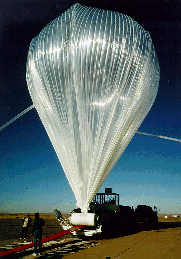 |
Balloons have been used for decades to conduct scientific studies. While
the basics of ballooning have not changed, balloon capabilities have
increased and their dependability has improved greatly.
Scientific Balloons...
1. can be launched from locations worldwide to suport scientific needs.
2. can be readied for flight in as little as six months.
3. offer a low-cost method of conducting science investigations.
4. provide a stable platform for longer flight durations.
Scientists use scientific data collected during balloon flights to help
answer important questions about the universe, atmosphere, the Sun and the
space environment. Questions such as "How did the universe, galaxies,
stars, and planets form and evolve?" and "Are there Earth-like planets
beyond our solar system?" are being answered by NASA with the help of
experiments flown on scientific ballons.
|
|
|
Standard NASA scientific balloons are constructed of polyethylene film; the
same type material used for plastic bags. This material is only 0.002
centimeters (0.0008 inches) thick, about the same as an ordinary sandwich
wrap. The film is cut into banana-peel shaped sections called gores and
heat sealed together to form the balloon. Up to 180 gores are used to make
NASA's largest balloons. These standard, zero-pressure, balloons are open
to the atmosphere at the bottom to equalize the internal pressure with the
surroundings. The balloon system includes the balloon, the parachute and a
payload that holds instuments to conduct scientific measurements.
Helium, the same gas used to fill party balloons, is used in NASA balloons.
These very large balloons can carry a payload weighing as much as 3,600
kilograms (8,000 pounds), about the weight of three small cars. They can
fly up to 42 kilometers (26 miles) high and stay there for up to two weeks.
The Balloon Program's capabilities are being expanded with the development
of an Ultra Long Duration Balloon (ULDB). The ULDB is made of advanced
materials and uses a new pumpkin-shaped balloon design to achieve flights of
up to 100 days. The ULDB is completely sealed and pressurized in order to
maintain constant altitude night and day. The ULDB payload consists of a
solar power system, radio receivers and transmitters, computers, batteries
and other systems required for science experiments.
The balloon is launched by partially filling it with helium and launched
with the payload section suspended beneath it. As the balloon rises, the
helium expands, filling the balloon until it reaches float altitude in two
to three hours.
After the science measurements are complete, flight controllers send a radio
command that separates the payload from the balloon. The payload floats
back to the ground on a parachute where it can be retrieved and flown again.
Payload separation creates a large tear in the balloon material, which
releases any remaining helium. The balloon also falls to the ground, where
it s retrieved and discarded. The balloon and payload land approximately 45
minutes after separation.
(Special thanks to the Balloon Program
Office at Wallops Flight Facility.)
|
